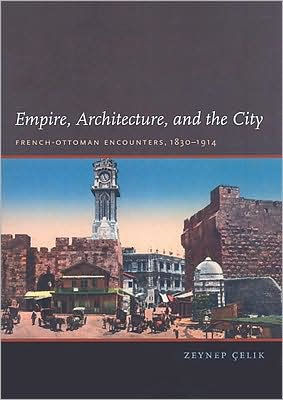
Empire, Architecture, and the City: French-Ottoman Encounters, 1830-1914
368
Empire, Architecture, and the City: French-Ottoman Encounters, 1830-1914
368Hardcover
-
PICK UP IN STORECheck Availability at Nearby Stores
Available within 2 business hours
Related collections and offers
Overview

Product Details
| ISBN-13: | 9780295987798 |
|---|---|
| Publisher: | University of Washington Press |
| Publication date: | 11/03/2008 |
| Series: | Studies in Modernity and National Identity |
| Pages: | 368 |
| Product dimensions: | 7.40(w) x 10.30(h) x 1.00(d) |
| Age Range: | 18 Years |
About the Author
Table of Contents
AcknowledgmentsA Note on Transliterations and DatesIntroductionColor Plates1. Imperial Infrastructures2. Transforming Urban Fabrics3. New Public Spaces4. A New Monumentality and an Official Architecture5. Affirming Empire: Public CeremoniesEpilogueNotesBibliographyIndexWhat People are Saying About This
This is an extremely significant project since it fundamentally questions and, through its judicious deployment of extensive data, demonstrates that the old binary of East versus West, Islam versus Christianity, can not historically be defended.
"This is an extremely significant project since it fundamentally questions and, through its judicious deployment of extensive data, demonstrates that the old binary of East versus West, Islam versus Christianity, can not historically be defended."
"In her remarkably researched study, Zeynep Celik not only constructs an innovative parallel between a dwindling empire and a developing one, but she also sheds light on the mutual observation policies of Turkey and France. Empire, Architecture, and the City sets new standards in the study of colonial city planning and building design, challenging accepted views on European domination, thanks to a precise comparison of the agents and ideologies at work."
In her remarkably researched study, Zeynep Celik not only constructs an innovative parallel between a dwindling empire and a developing one, but she also sheds light on the mutual observation policies of Turkey and France. Empire, Architecture, and the City sets new standards in the study of colonial city planning and building design, challenging accepted views on European domination, thanks to a precise comparison of the agents and ideologies at work.
"Empire, Architecture, and the City is very original for its in—depth comparison of the Ottoman and French empires in Arab regions, their political policies, and architectural and ceremonial symbols. The comparison turns out to be an effective way of explaining common themes and variations, mutual influences, and the differences between the empires."
"In her remarkably researched study, Zeynep Celik not only constructs an innovative parallel between a dwindling empire and a developing one, but she also sheds light on the mutual observation policies of Turkey and France. Empire, Architecture, and the City sets new standards in the study of colonial city planning and building design, challenging accepted views on European domination, thanks to a precise comparison of the agents and ideologies at work."—Jean—Louis Cohen, Sheldon H. Solow Professor in the History of Architecture, New York University
"Empire, Architecture, and the City is very original for its in—depth comparison of the Ottoman and French empires in Arab regions, their political policies, and architectural and ceremonial symbols. The comparison turns out to be an effective way of explaining common themes and variations, mutual influences, and the differences between the empires."—Ira M. Lapidus, Professor Emeritus, University of California, Berkeley
"This is an extremely significant project since it fundamentally questions and, through its judicious deployment of extensive data, demonstrates that the old binary of East versus West, Islam versus Christianity, can not historically be defended."—Julia Clancy—Smith, Department of History, University of Arizona
This is an extremely significant project since it fundamentally questions and, through its judicious deployment of extensive data, demonstrates that the old binary of East versus West, Islam versus Christianity, can not historically be defended.
In her remarkably researched study, Zeynep Celik not only constructs an innovative parallel between a dwindling empire and a developing one, but she also sheds light on the mutual observation policies of Turkey and France. Empire, Architecture, and the City sets new standards in the study of colonial city planning and building design, challenging accepted views on European domination, thanks to a precise comparison of the agents and ideologies at work.
